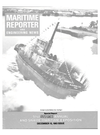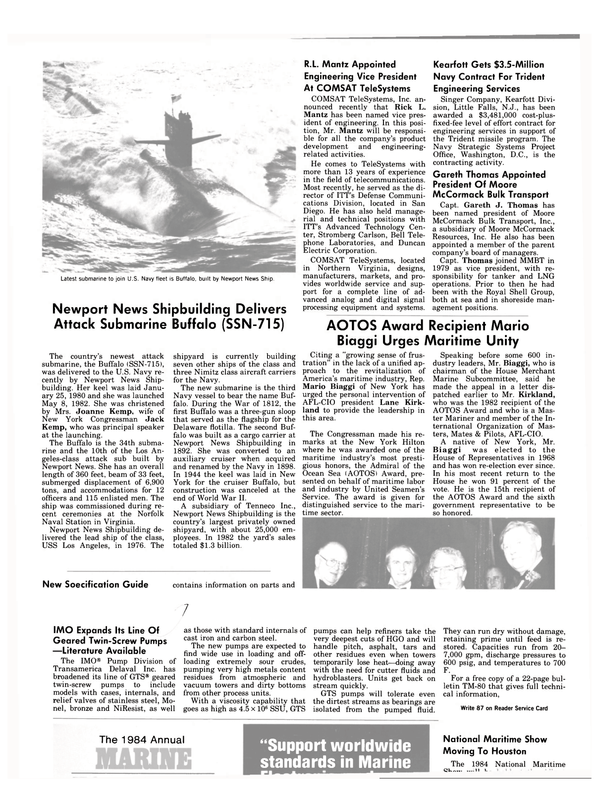
Gladding-Hearn Delivers Two Launches To Virginia Pilots
No matter what line of business you're in, prompt and responsive service to your clients is an absolute essential. No one recognizes this fact more than the Virginia Pilots Association of Norfolk, an organization that is continually looking for ways to improve its operations and better serve the ships that call at Virginia ports.
In line with this philosophy, the VPA recently initiated a major change that will eventually move its center of operations to a landbased control tower. To be built at Cape Henry, this modern, computerized tower will become headquarters for the Association, replacing its 48-year-old pilot station vessel.
Of course, when you plan to move your base of operations miles away from your actual sea duty area, you have to consider some other factors as well—like acquiring pilot boats that offer high speed, proven performance, and allweather reliability. That's where Gladding- Hearn, the Somerset, Mass., shipbuilder came into the picture.
Completing a contract awarded in the fall of 1982, Gladding-Hearn recently delivered two 51-foot, fast pilot launches to the VPA. The all-aluminum, twin-screw vessels will play a pivotal role in the new scheme of operations for the Virginia Pilots. Designed by C. Raymond Hunt Associates of Boston, and featuring the proven Hunt "Deep-Vee" planing hull, these high-performance craft have been put into service as the first phase of the major operational change.
The new boats, named the Virginia and the Old Dominion, are the sixth and seventh in a class originally designed by Gladding-Hearn for the Delaware Bay Pilots. With a beam of 17 feet and draft of 4.5 feet, they have a top speed of 23 knots and will cruise at 20 knots.
To be based at Lynnhaven River, the new launches will be directed by traffic controllers in the new land-based tower. The controllers will use the most modern guidance equipment and methods to coordinate arriving and departing ships with pilot assignments.
Powered by twin GM Detroit Diesel Allison engines, each rated for 350 bhp at 2,100 rpm, the launches feature clear flush decks and an amidships wheel house with cabin-top boarding platform. The hot-water-heated deck house provides raised reclining seats for four (including helmsman), as well as a full-width bench seat, and a full complement of instrumentation and communication/navigation equipment. Accommodations include two settee berths, head, and wash basin.
The Hunt-designed hull comprises four watertight compartments served by an engine enginedriven bilge pump. Forward and aft decks are fitted with safety handrails and have heated walkways for de-icing. A water-level rescue platform is recessed into the transom.
The trend-setting change in operations being undertaken by the Virginia Pilots Association makes good sense in many ways—in economics, efficiency, and operational safety. When the move ashore is completed, the high costs of maintaining its aging pilot station vessel (about $1 million a year) will be eliminated.
Time will be saved for both the pilots and the vessels they serve, and pilots' exposure at sea in bad weather will be reduced significantly.
Read Gladding-Hearn Delivers Two Launches To Virginia Pilots in Pdf, Flash or Html5 edition of December 15, 1983 Maritime Reporter
Other stories from December 15, 1983 issue
Content
- Upgraded Facilities Dedicated At Newfoundland Dockyard page: 6
- Raytheon Marine Names John Scott Marketing And Sales Manager, Europe page: 7
- Texas Instruments Offers Platinum-Clad Anodes For Corrosion Protection —Literature Available page: 7
- Carrington Delivers The Blackburn Cove page: 8
- Report On Navy Market Available From IMA page: 8
- Los Angeles SNAME Discusses Offshore Problems And Solutions page: 8
- New Data Sheet Analyzing Combustion Efficiency Available From Howe-Baker page: 9
- MacGregor-Navire Cargo Access Equipment Ordered For Blue Star Reefers page: 9
- Jacobs Joins Contromatics In Marketing/Sales Position page: 10
- Malcomson Named Manager Of Manufacturing For Raytheon And Sorensen page: 10
- MSC Awards $200 Million In Contracts For Four More SL-7 Conversions page: 12
- Aqua-Chem Introduces New Plate-Type Evaporator —Literature Available page: 13
- Wesmar Sonar Effective In Shallow-Water Operations —Literature Available page: 13
- Frigate De Wert (FFG-45) Delivered Early By Bath Iron Works page: 14
- Navy Rescue/Salvage Vessel Launched At Peterson Builders page: 15
- Jackup Rig For West Africa Launched At Promet Yard page: 18
- Work Progressing On USS Kalamazoo Overhaul At Hoboken Shipyards page: 18
- The 91st SNAME Annual Meeting A Special Post-Meeting And Exposition Report page: 20
- Navy Extends Contracts With COMSAT General For Use Of MARISAT page: 27
- Kockums Profit Continues With Backlog of Orders Worth SEK 4,700 Million page: 28
- Marpol/Solas Compliance Subject Of 60-Page Book Offered By Intertanko page: 28
- Harland & Wolff To Build And Market Friendship Multi-Purpose Cargo Ship page: 28
- Maritime Protection Unveils New Nitrogen Generator— Literature Available page: 29
- $30-Million Navy Contract On Landing Craft Awarded To Bell Aerospace Textron page: 30
- First Of Sulzer's New RTA Engine Series Powers Mitsubishi-Built Bulker page: 30
- American-Standard Opens New Jersey Repair Plant —Literature Available page: 31
- Gladding-Hearn Delivers Two Launches To Virginia Pilots page: 34
- Newfoundland's Windsor Cites $93 Million In New Projects page: 34
- Nylands Expands Its Diesel Spares Operations —New Catalog Available page: 35
- Newport News Shipbuilding Delivers Attack Submarine Buffalo (SSN-715) page: 36
- AOTOS Award Recipient Mario Biaggi Urges Maritime Unity page: 36
- Crane Packing Offers Brochure On New Metal Bellows Pump Shaft Seal page: 37
- Novel Hagglunds Cranes Retrofitted On Cargo Ship Built In Shanghai page: 37
- IMO Expands Its Line Of Geared Twin-Screw Pumps —Literature Available page: 38
- New Navidyne Option Reports Ship's Position In Response To Telex Call page: 38
- Epton Completes Order For Canada's Largest Marine Fenders page: 39
- Philadelphia Gear Licensed To Manufacture I Hi's Duckpeller page: 39
- Daewoo Delivers Second $80-Million Pacesetter Rig To Santa Fe Drilling page: 40
- WESMAR Presents Stability Computer To 'President Lincoln' —Literature Available page: 40
- McDermott Shipyards To Build Inter-Island Barge For Matson page: 41
- New Tunnel Thruster Model Introduced By Omnithruster page: 50
- Bell Aerospace Awarded Navy Contract For Final Phase Of Minesweeper Hunter Design page: 50


